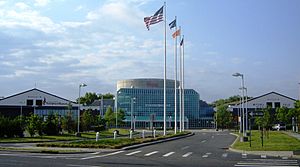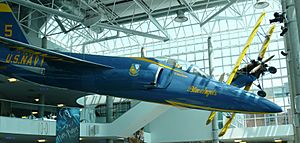Cradle of Aviation Museum facts for kids
 |
|
| Lua error in Module:Location_map at line 420: attempt to index field 'wikibase' (a nil value). | |
| Location | Uniondale, New York |
|---|---|
| Type | Aviation museum |
| Founder | George C. Dade |
| Public transit access | LIRR stations: Garden City, Mineola, Westbury |
The Cradle of Aviation Museum is an exciting aerospace museum on Long Island, New York. It's located in Uniondale, New York, in an area called East Garden City. This museum celebrates Long Island's huge role in the history of aviation, which is the science of flying.
The museum sits on land that used to be part of Mitchel Air Force Base. This base, along with other nearby airfields like Roosevelt Field, was where many famous flights took off. So many important flights happened here that by the 1920s, people started calling this area the "Cradle of Aviation." That's how the museum got its name! Today, Flagstar Bank helps support the museum.
Contents
Long Island: Where Aviation Began
Long Island earned its nickname, the "Cradle of Aviation," because of many amazing "firsts" in flight history. Here are some of them:
- 1873 – The first recorded flight over Long Island happened. A balloon pilot named W. H. Donaldson flew from Brooklyn to Queens Village.
- 1874 – More balloon flights took place, including trips from New York City to Lynbrook and from Lynbrook to Hempstead.
- 1909 – Glenn Curtiss flew his plane 25 miles from Mineola. He won the Scientific American Prize for this flight.
- 1910 – A big flying competition, the International Aerial Tournament, was held at Belmont Park.
- 1911 – Cal Rodgers made the first flight across the entire United States! He flew his plane, the Vin Fiz Flyer, from Sheepshead Bay, New York, all the way to California.
- 1916 – The first flight ever made at night happened here.
- 1917 – The first flight of a pilotless aircraft, called the Sperry Aerial Torpedo, took place. This was like an early drone!
- 1919 – The first airplane flight across the Atlantic Ocean happened. A US Navy NC-4 flying boat started from NAS Rockaway, Long Island, and landed in Plymouth, England, after several stops.
- 1919 – The first airship (a type of blimp) to cross the Atlantic, called the R34 (airship), arrived at Roosevelt Field from England.
- 1923 – The first non-stop airplane flight across the U.S. happened. John A. Macready and Oakley G. Kelly flew from Mitchel Field to San Diego, California.
- 1924 – The first flight around the world finished its journey at Mitchel Field.
- 1927 – Charles Lindbergh made the first solo flight across the Atlantic Ocean. He flew from Roosevelt Field to Paris, France, all by himself!
- 1927 – The first transatlantic flight with passengers happened. Clarence D. Chamberlin flew from Roosevelt Field to Eisleben, Germany.
- 1929 – The first "blind" instrument flight was made by Jimmy Doolittle at Mitchel Field. This meant he flew only using instruments, not by looking outside. Companies on Long Island helped create these important instruments.
William K. Kaiser, the museum's first curator, was also part of an aviation first. In 1944, as a young officer in the U.S. Navy, he was one of the pilots on the first transatlantic crossing by non-rigid airships. He was later honored for his work at the museum.
How the Museum Started
The idea for the Cradle of Aviation Museum began with William K. Kaiser and George C. Dade, who became the museum's first director. They worked with volunteers to find and fix up old aircraft. These planes were important because they were part of Long Island's aviation history or were built by local aerospace companies.
Their first plane was a World War I Curtiss JN-4D. George Dade found it in a pig barn in Iowa in 1973! Later, Charles Lindbergh himself confirmed that this was his very first airplane. By 1979, the museum also had other famous planes like a Ryan Brougham (similar to Lindbergh's Spirit of St. Louis), a Republic P-47N Thunderbolt, and a Grumman Lunar Module spacecraft.
These aircraft were meant for hangars 3 and 4 of Mitchel Air Force Base. Nassau County got these hangars when the base closed in 1961. The museum first opened in 1980 with just a few planes in these old hangars. Then, in the late 1990s, the museum had a big makeover and expansion. It reopened in 2002 as a modern, state-of-the-art facility.
Amazing Aircraft Collection
Today, the museum has over 70 aircraft and many scale models of planes from different time periods. You can see Charles Lindbergh's Curtiss Jenny plane, which he used for airshows. There's also an A-10 Thunderbolt II and a Grumman F-14 Tomcat.
One very special exhibit is an unused Apollo Lunar Module, called LM-13. This module was supposed to land on the Moon with the Apollo 19 mission. But the mission was canceled, so LM-13 stayed on Earth. It's displayed close to where it was built at the Grumman Aircraft Engineering Corporation in nearby Bethpage, New York.
Many of the museum's tour guides and people who restore the planes used to work at Grumman. Grumman was a big aerospace company that built many of the aircraft you see in the museum. The museum has eight galleries, arranged in time order, with about the same number of planes in each. It's one of the few museums in the U.S. that covers all parts of aviation and space history. This includes early pioneer planes, planes from the "Golden Age" of aviation, warplanes, civilian planes, and spacecraft.
The Cradle of Aviation Museum is a very popular air and space museum. It has cool audio-visual displays and unique hands-on exhibits. You can even try a "cockpit trail" where you get to sit in the cockpit of an aircraft from different eras! Joshua Stoff has been the museum's curator since 1985. He is a respected author about aerospace and an active member of the aviation museum community.
Besides the museum itself, the complex also has the JET BLUE DOME theater. Here, you can watch digital films and enjoy a digital planetarium. There's also a cafeteria for visitors.
Firefighter Museum
Inside the same building as the Cradle of Aviation Museum, you'll find the Nassau County Firefighter's Museum and Education Center. It's a large, interactive space, almost 10,000 square feet! Visitors can learn about the history of firefighting in Nassau County. There are hands-on exhibits with old and new fire trucks and firefighter gear.
Gallery
-
Folded wing of Grumman F6F Hellcat
-
Charles Lindbergh's flight gear
See also
- List of aerospace museums
- Statue of Sally Ride, which stands outside of the museum








